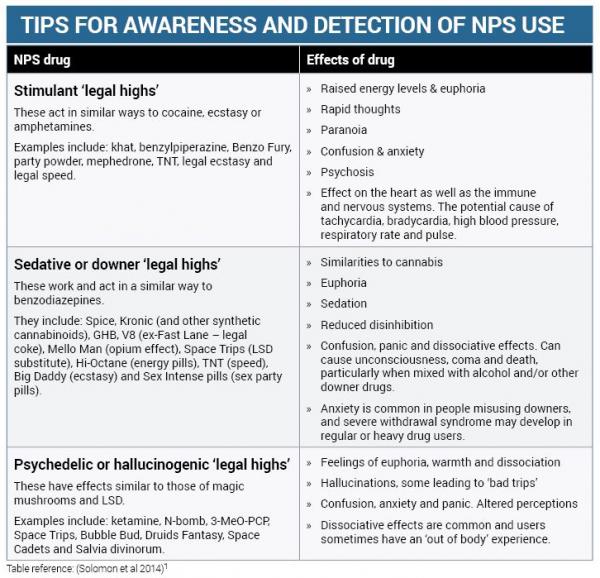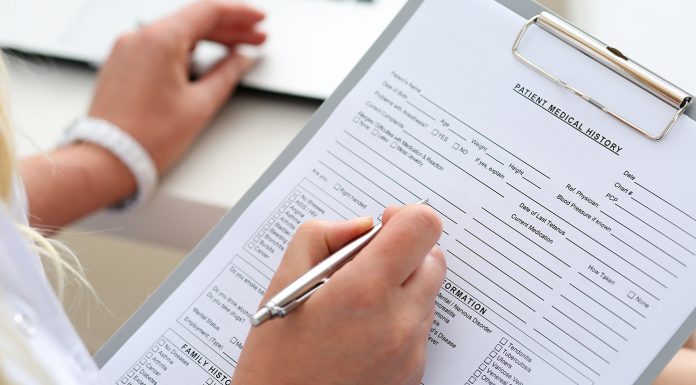Reading this article and undertaking the learning activity is equivalent to 60 minutes of professional development.
This learning activity is relevant to the Nursing Council competencies 1.4, 1.5, 2.1, 2.8, 3.1, 3.2 & 3.3.
Learning outcomes
- increase your knowledge of novel psychoactive substances (NPS) and how they affect mental health
- identify potential physical health and mental health risks resulting from NPS use for clients in your area of nursing
- increase your understanding of co-existing substance use and mental health problems and some approaches to managing clients that misuse substances like NPS.
Introduction
Novel psychoactive substances (NPS) or the so-called ‘legal highs’ are emerging rapidly worldwide, as are concerns about NPS abuse.
NPS have been a growing trend over the past decade for a number of reasons, including difficulties detecting them in routine urine drug screens, legal loopholes, easy access through the internet and low cost1.
Labelling these drugs as ‘herbal highs’ or ‘legal highs’ is misleading as there is nothing natural about these synthetic and untested drugs and also currently none of them are legal in New Zealand2. But there has been an explosion in numbers of NPS worldwide with the European Monitoring Centre for Drugs and Drug Addiction (EMCDDA) reporting this year that it is now monitoring 560 NPS and 98 new substances that were reported for the first in 2015 and 101 in 20143.
There are several typical categories of NPS drugs including synthetic cathinones (e.g. mephedrone and MDPV), plant-based NPS (e.g. khat and salvia divinorum), synthetic cannabinoids (e.g ‘Spice’, ‘Kronic’ and ‘K2’), and ‘party’ drugs like benzylpiperazine (BZP).
Synthetic drugs can be taken through insufflation (snorting), oral ingestion and rectal insertion, as well as being taken intravenously, intramuscularly and subcutaneously.
These drugs are considered to have an effect on mental health wellbeing. Identified mental health symptoms that can result from NPS use are low mood, confusion, and anxiety1.
The European Monitoring Centre for Drugs and Drug Addiction (EMCDDA)4 identified synthetic cannabinoids as prominent in affecting mood and perception and that intoxications can cause agitation, tachycardia, and arterial hypertension. The centre says that synthetic cannabinoids are 100 times more powerful than traditional strains of cannabis4.
The EMCDDA also identified synthetic cathinones as hallucinogenic stimulants with cardiovascular and psychiatric side effects.
The number of deaths involving NPS increased by 15 per cent in 2013 in the United Kingdom, with 60 deaths, up from 52 deaths in 20125. New Zealand attempted temporary bans on different NPS before passing the Psychoactive Substances Act in 2013, which puts the responsibility on NPS producers or importers to prove they are low risk6. At present no NPS products are legally available for sale in New Zealand2, but the the ingredients for making illicit drugs are still available for purchase on untraceable internet sites so access to NPS continues.
Detection of NPS use can be difficult as adult users – who usually present with agitation, cardiovascular and psychiatric symptoms – can often pass urine drug screening due to the lack of detectable metabolites. To further complicate matters, the molecular makeup of NPS drugs can be changed slightly to make detection through urine drug screening tests even more difficult7.
It has been suggested that health professionals, for example, in emergency departments, primary health and mental health services, need to be made aware of the growing levels of NPS misuse so that it can be identified and treated accordingly7.
Examples of NPS and the risks they could pose to the people you nurse
It is useful for nurses to have an understanding of the potential risks of NPS. Nurses also need to maintain a therapeutic relationship that is respectful of the individual’s choices, experiences and expertise11,12.
This section looks at some of the NPS currently available.
Synthetic cathinones
Mephedrone is one of a group of synthetic cathinone drugs that are chemically similar to amphetamines. Another is methylenedioxypyrovalerone (MDPV). Synthetic cathinones can result in the stimulation of psychosis, neurological and other health complications. Mental health professional intervention is needed for people with mental health problems as a result of mephedrone misuse.
Synthetic cathinones have been found to have similar effects to psychostimulatory drugs of misuse including cocaine, amphetamine and MDMA (ecstasy). Psychiatric symptoms as a result of mephedrone/cathinone misuse include aggression, agitation, anhedonia, anxiety, confusion, delusions, depression, dysphoria, irritability, loosening of association, mental fatigue, panic attacks, paranoia, perceptual distortion, psychosis, self-mutilation, suicidal thoughts/suicide and visual and auditory hallucinations. Addictive symptoms identified include tolerance, craving and withdrawal syndrome13.
’N-Bomb’ or NBOMe
The psychedelic drug commonly known as ‘N-Bomb’ (25I-NBOMe, 2C-I-NBOMe) is a powerful hallucinogen that has been prevalent in New Zealand since 201214. N-Bomb’s high potency increases risks of toxicity in small doses. Common routes of administration include sublingual, buccal, and nasal/intranasal15.
The hallucinogenic effects of N-Bombs mimic LSD and can last between six and 10 hours and include feelings of euphoria, mental and physical stimulation, a pleasant or positive change in consciousness and unusual body sensations. Risks include tachycardia, hypertension, pyrexia, agitation, hallucinations, seizures and death. There have been media reports in New Zealand of renal and cardiovascular complications following use and overseas there have been a number of N-Bomb-related deaths14.
Spice and other synthetic cannabinoids
The misuse of ‘Spice’ or synthetic cannabinoids is increasing among teenagers and adults. Spice has over 220 compounds in various different combinations or brands16. There is also a risk of Spice causing psychopathological disturbances, namely psychosis, causing what is known as “Spiceophrenia”.
Spice can affect a person’s physical state and can trigger vomiting, seizures, tachycardia, mydriasis, hypertension, confusion and restlessness. Mental health symptoms include delusions, paranoia, disorganised thought and visual and auditory hallucinations. Fluctuating mood, anxiety, perception, thinking, memory, and attention is common. Agitation, panic, dysphoria, psychosis and bizarre behaviour are also common17.
Khat*
The khat plant, better known as ‘Catha edulis’, has been chewed by Eastern Somalian and some Islamic communities since 640 AD. Over the past century synthetic cathinones have been derived from this traditional plant to produce NPS.
Khat is known for its stimulant effect similar to amphetamine; there have been numerous disputes around the mental health harms of using khat27, but there is an increased risk for psychotic episodes, similar to stimulant (cocaine or amphetamine) and drug-induced psychosis28.
GHB and GBL*
GHB (gamma-hydroxybutyrate) and GBL (gamma-butyrolactone) are illicit drugs with similar sedative and anaesthetic effects. GBL is converted to GHB shortly after entering the body. Both produce a feeling of euphoria and can reduce inhibitions and cause sleepiness. Dependence is rare but users of these compounds can develop tolerance and cravings. Many users complain of insomnia, anxiety and depression29
Ketamine and 3-MeO-PCP*
Other illicit drugs that affect mental health include ketamine, which is a short-acting dissociate (a class of hallucinogens) compound with anaesthetic and analgesic use. Ketamine’s effects reportedly last two hours and visual hallucinations are common.
Transient psychological experiences include anxiety, paranoia and disturbing hallucinations20. Another dissociative anaesthetic drug marketed as an NPS is 3-Methoxyphencyclidine (3-MeO-PCP). There is also some clinical evidence to suggest that intravenous ketamine infusion has been found to be safe and effective for refractory depression and suicidal ideation. However, this is not practical for maintenance therapy long term30.
Why may people who experience MH issues use NPS?
There are various reasons for the prevalence of people with mental health problems abusing illicit substances like NPS. This includes the cheap availability of NPS, accessibility and peer pressure1.
Also, according to Ponizovsky et al18, people with co-existing problems are more at risk of non-adherence to prescribed medication and therefore more prone to relapse, rehospitalisation, and illicit drug and alcohol use.
One recent research study talks about mental health service users using illicit drugs to control their distressing symptoms, or to “relax” and to get “high”19. The findings of this empirical study suggest that substance use was related to controlling emotional states, anxiety, and depression. Alcohol was seen as less harmful than cannabis and other psychoactive compounds in the perception of the mentally ill substance user. Counteracting psychiatric medication side effects was also identified as a reason, alongside controlling psychotic states, i.e. managing auditory hallucinations by smoking more cannabis. So nurses should be aware that some clients may ‘manage’ mental health symptoms with illicit drugs and alcohol.
Mental health professionals use a range of patient-centred and focused risk assessments that have been formulated specifically for people with co-existing problems9,20.
One harm reduction approach to tackling NPS or other substance misuse, that can be done in non-specialist addiction settings like primary health, is using a brief assessment tool to assess whether alcohol or drug problems are at the ‘social or harmless use’ end of the continuum or the ‘moderate to severe’. This helps identify the level of intervention needed with mild problems usually just needing a brief intervention to reduce use to safe levels, while ‘moderate to severe’ problems require a comprehensive assessment and management plan9.
Co-existing problem approaches
The New Zealand guidelines for the assessment and management of co-existing problems9 take a client-centred approach.
The guidelines set out seven key principles, including screening all clients presenting in mental health and addiction services for CEP and, if positive, undertaking a comprehensive assessment that gives equal weight to both mental health and substance use problems. Also emphasised is safety, stabilisation, engaging with clients by developing a ‘trusting, empathetic and non-judgemental therapeutic relationship’, taking cultural needs and general wellbeing into consideration; and that CEP management should include strategies to enhance motivation, deliver interventions appropriate to the nature and severity of the problems, and provide integrated care9.
Barriers to CEP treatment can be prevalent across health settings due to miscommunication, lack of awareness and inappropriate referrals between mental health, substance misuse and community services8. There is a need for co-ordination between services, effective policies, protocols and effective clinical leadership. A clear referral pathway to addiction and mental health services is also needed8.
Psychosocial interventions helpful for clients who use NPS
Psychosocial interventions can be beneficial in the treatment of substance use problems including NPS.
The traditional approach for treating drug problems includes medication approaches and psychosocial (psychology-based) interventions. Psychosocial interventions include treatments such as cognitive behavioural therapy (CBT) that aims to modify cognitive processes and behaviour21 and can be used as an approach to enhance subjective wellbeing8.
Motivational interviewing (MI) is a common psychosocial intervention aimed at enhancing motivation and readiness for treatment. Miller and Rollnick define motivational interviewing as a non-judgmental, non-confrontational and non-adversarial approach that enhances a person’s awareness of the problems caused and the consequences experienced as a result of their behaviour e.g. alcohol dependence22.
Motivation – including strategies to enhance motivation like CEP-adapted motivational interviewing (MI) – is one of the seven key principles of CEP treatment in New Zealand9. New developments in MI include an increased emphasis on the client’s hopes and values and structured first interviews aimed at enhancing engagement in treatment9.
Contingency management is another psychosocial technique that provides a system of incentives or reinforcement to encourage abstinence. Dutra et al23 suggest drug abstinence increased by using strategies such as food vouchers, money or other incentives for positive behaviour. Other emerging psychosocial approaches that the 2010 New Zealand guidelines say show promise include kaupapa Māori approaches, mindfulness, and acceptance and commitment therapy9.

Co-existing problems
Mental health problems are widely associated with substance misuse, including the use of legal highs. There are a range of terms used to describe this combination of problems, including dual diagnosis, but the term ‘co-existing substance use and mental health problems’, or co-existing problems (CEP) for short, is used in New Zealand with ‘co-existing’ chosen as it implies interaction more than ‘co-occurring’8.
CEP are highly prevalent in therapeutic settings in New Zealand with an estimated third to half of all tangata whaiora (service clients) in mental health settings likely to have current CEP and up to three-quarters of clients seeing addiction services9. People with severe CEP experience higher rates of institutionalisation, more failed treatment attempts, poverty, homelessness and risk of suicide8.
It is estimated that 40 per cent of people with psychosis also have substance misuse problems. People with co-existing substance use and mental health disorders have higher rates of unmet needs and a higher rate of relapse and hospitalisation than those who primarily have psychosis10.
It has been identified that some people with psychosis commonly misuse non-prescribed medication to deal with persisting psychiatric symptoms, which ultimately exacerbate psychiatric symptoms10.
Conclusion
Mental health problems as a result of adults misusing novel psychoactive substances (NPS) are emerging around the world and in New Zealand. Despite law changes, NPS – and the ingredients to make illicit drugs – are available to purchase on hidden internet sites that are untraceable to law enforcement worldwide.
There is a push in New Zealand to address co-existing problems (CEP) of mental health and substance use with strategies and guidelines8,9 and an updated blueprint for mental health24.
CEP is highly prevalent in New Zealand and NPS is a newly contributing factor. Therefore it is important that nurses have a knowledge and understanding of substance use and CEP issues in general, including the common effects and risks of NPS use.
Collaboration and partnerships between mental health, addiction, primary care and other areas of nursing are essential to providing a safe and harm reduction approach to substance misuse. Monitoring, early detection, engagement with clients and using suitable interventions are very important in minimising harm from NPS and other substance use. These approaches are inherent to the addiction nursing framework25, the mental health nursing standards of practice and the New Zealand College of Mental Health Nurses credentialing programme for primary care nurses26.
At present the research on managing NPS misuse is limited and there is a need to identify interventions that health professionals agree can work in managing co-existing problems resulting from NPS misuse. Services also need to respond early to communication problems and interface issues between services that can create barriers for CEP clients receiving access to mental health and drug treatments.
Poor mental health is disempowering for substance users and health professionals need to acknowledge personal experiences, empower recovery and improve the quality of life for people with mental health issues11,12.
View PDF of this article (including related learning activity) here >>
Recommended further resources
New Zealand Drug Foundation: Aimed at preventing and reducing harm from drug use and includes information on NPS used in New Zealand www.drugfoundation.org.nz
Psychoactive Substances Regulatory Authority: Information on New Zealand’s ‘legal highs’ regulation system
http://psychoactives.health.govt.nz
NEPTUNE (Novel Psychoactive Treatment UK Network): guidance on managing harm from NPS http://goo.gl/XZ4WN1
Toxinz: National poisons information database www.toxinz.com
NICE (National Institute for Health and Care Excellence): UK site with pathway for psychosis with coexisting substance misuse http://goo.gl/xC63LH
FRANK: UK site offering ‘friendly, confidential drugs advice’ www.talktofrank.com/drug/n-bomb
About the authors:
David Solomon MSc, PG Cert HE, BSc (Hons), Fellow of Higher Education. Independent Prescriber; RMN. Senior Lecturer, Nurse, Faculty of Health, Social Care and Education, Essex, Anglia Ruskin University.
Bernadette Solomon DHSc candidate, MSc (Applied Criminology), PG Cert HE, RMN. Professional Teaching Fellow, Faculty of Medical and Health Sciences: Mental Health and Addictions, the University of Auckland, New Zealand.
This article was peer reviewed by:
Daryle Deering RN PhD is a senior lecturer at the National Addiction Centre, the University of Otago.
Louise Leonard RN NP BA (Psych) MNurs is a nurse practitioner working in alcohol and other drug addictions for Waikato District Health Board’s mental health and addiction services.
*These sections were cut from the print version of the article and have been re-instated into the online version with references added to bottom of reference list.
REFERENCES
- Solomon D, Grewal P, Taylor C, Solomon B (2014). Managing misuse of novel psychoactive substances. Nursing Times 110(22): 12-15.
- Psychoactive Substances Regulatory Authority (2016) http://psychoactives.health.govt.nz (accessed June 20 2016).
- European Monitoring Centre for Drugs and Drug Addiction (2016) European Drug Report 2016: Trends and Developments. http://goo.gl/mZviw5
- European Monitoring Centre for Drugs and Drug Addiction (2013). European Drug Report 2013: Trends and Developments.
- Office for National Statistics (2013) Deaths related to drug poisoning in England and Wales: 2013. http://goo.gl/nq8wkg
- NZ Drug Foundation (2014) http://goo.gl/hNxNYV (accessed June 20 2016).
- Bajaj J, Mullen D, Wylie S (2010) Dependence and psychosis with 4-methylmethcathinone (mephedrone) use. BMJ Case Reports 2010.
- Ministry of Health (2010). Service delivery for people with co-existing mental health and addiction problems. Ministry of Health, Wellington.
- Todd F (2010) Te Ariari o te Oranga: The assessment and management of people with co-existing mental health and substance use problems. Ministry of Health, Wellington.
- Copello A, Walsh K et al (2013). A consultation-liaison service on integrated treatment: A program description Journal of Dual Diagnosis 9(2): 149-157.
- Barker P (2001). The Tidal Model: developing an empowering, person-centred approach to recovery within psychiatric and mental health nursing. Journal of Psychiatric and Mental Health Nursing 8: 233-240.
- Barker P, Buchanan P (2011). Myth of mental health nursing and the challenge of recovery. International Journal of Mental Health Nursing 20: 337-344.
- Advisory Council on the Misuse of Drugs (2010). ACMD report on the consideration of the cathinones. London. Available at www.homeoffice.gov.uk.
- NZ Drug Foundation (2014). http://drugfoundation.org.nz/matters-of-substance/NBOMe (accessed June 22 2016)
- Rose S, Poklis J, Poklis A (2013). A case of 25I-NBOMe (25-I) intoxication: a new potent 5-HT2A agonist designer drug. Clinical Toxicology 51: 174-177.
- Schifano F, Corazza O, Deluca P, Davey P, Davey Z (2009). Psychoactive drug or mystical incense? Overview of the online available information on Spice products. Journal of Culture and Mental Health 2(2): 137-144.
- Mustata C, Torrens M, Pardo R, Perez C et al (2009). The Psychonaut Web Mapping Group. Spice drugs: Cannabinoids as new designer drugs [Spanish]. Adicciones 21(3): 181-186.
- Ponizovsky A et al (2015). Trends in dual diagnosis of severe mental illness and substance use disorders, 1996-2010, Israel. Drug and Alcohol Dependence 148.
- Petterson H, Ruud H et al (2013). Empirical study: Walking the fine line: Self-reported reasons for substance use in persons with severe mental illness. Int J Qualitative Stud Health Well-being 8: 21968.
- Matua Raki (2012). Co-existing problems (CEP) service checklist http://goo.gl/MIiBHc.
- Conrod P, Stewart S (2005). A critical look at dual-focused cognitive-behavioral treatments for comorbid substance use and psychiatric disorders: Strengths, limitations, and future directions. Journal of Cognitive Psychotherapy 19(3): 261-284.
- Miller W, Rollnick S (2002). Motivational interviewing: Preparing people for change. Guilford Press, New York.
- Dutra L et al (2008). A meta-analytic review of psychosocial interventions for substance use disorders. American Journal of Psychiatry 165(2): 179-187.
- Mental Health Commission (2012). Improving mental health and wellbeing for all New Zealanders: A companion document to Blueprint II. Accessed at: https://goo.gl/4dGv80.
- Drug and Alcohol Nurses of Australasia (2012). Addiction specialty nursing competency framework for New Zealand, Matua Raki, Wellington. http://goo.gl/9MlxWG
- New Zealand College of Mental Health Nurses (2012). Standards of Practice for Mental Health Nursing in New Zealand Aotearoa 3rd Edition. Te Ao Māramatanga New Zealand College of Mental Health Nurses, Auckland. www.nzcmhn.org.nz.
- Hoffman R, Mustafa A (2013). Concurrent use of khat and tobacco is associated with verbal learning and delayed recall deficits. Addiction 108(10).
- Warfa N, Klein A, Bhui K, Leavey G, Craig T et al (2007). Khat use and mental illness: a critical review. Soc Sci Med 65: 309-318.
- Winstock A, Mitcheson L (2012). New recreational drugs and the primary care approach to patients who use them. BMJ 344(288).
- Andrade C (2015). Ketamine safety and tolerability in clinical trials for treatment-resistant depression. J Clin Psychiatry 76(3): 247-252.























